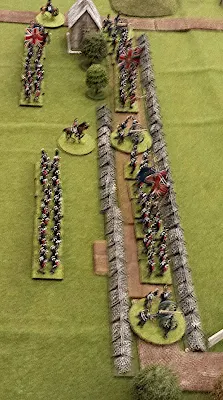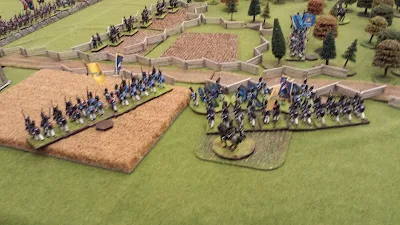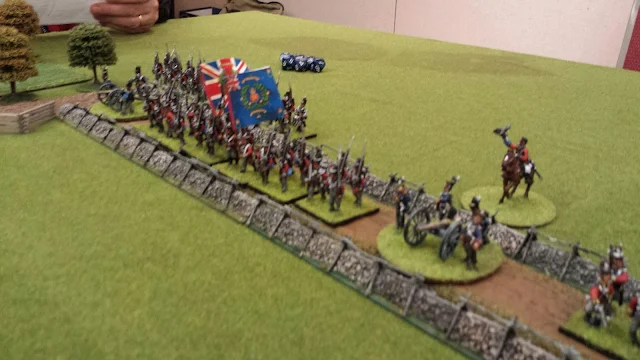I was invited to game night with my old club, the northern conspiracy. They are a great bunch of people and they put on magnificent games. Sad to say back about twelve years ago I had to drop out of the club due to a career change and new work hours. So my return was very exciting and enjoyable for me. I hope this will mark my return to the club.
My game was set in the War of 1812 during the Niagara campaign. A larger American force was advancing and needed to clear a road junction and two small farms owned by the brothers McKenzie (Bob and Doug). The smaller British/Canadian forces needed to hold them up to buy time. The rules used were Fife and Drum rules for the American Revolution. Terrain was plentiful (perhaps too plentiful!) With a nice old school look to everything.
The British/Canadians commanders (Greg and Ralph) placed their line troops (1st, 8th, 100th, 2nd Lincoln militia and Volunteers incorporated militia) defending a stone wall and a long ridge line.
Artillery was place along the road with clear fields of fire to the front. The Light troops (Glengarry Light Infantry and Native American Indians) pushed forward in the woods.
The plan was to use the woods and light troops to delay the American advance while the line troops held a good solid defensive position.
The American forces (George, Kevin and Phil) divided their forces into three commands. Kevin took Ripleys
brigade (1st, 21st and 23rd) and advanced along the right flank. Phil took two battalions of Scott's brigade (9th and 11th) and both guns and advanced on the left flank.
George with two battalions of line 25th and 22nd) and two battalions of volunteers (New York and Pennsylvania) would clear the woods and attack the enemy line.
While the American right and left advanced quickly the center became bogged down against the pesky lights. The Indians especially were obnoxious, advancing and retreating and causing
numerous moral checks. A house rule we added was frest time Indians fire at you you check morale.
Phil's advance on the left and his artillery placement finally caused the Glengarry's to fall back to the main British line. The Indians followed and the American center finally came face to face with the British behind the stone wall. On
the right flank the Lincoln militia bravely held the ridge while the American 1st brigade advanced on them.
Kevin attacked the militia and drove them off the ridge. But Greg caused numerous casualties and caused two American battalions to go shaken. In the center
George charged the main British line, over running one of the guns. But the splendid 100th Regiment of Foot behind the stone wall won the melee against the volunteers and regulars. By this time it was time to pack up. Both sides felt the britidh/canadians had held up the Americans and could now withdraw with honour.
After the game all agreed it was a good time. The rules played well, but local additions and interpretation will be added for the next time. I put too much terrain out which slowed the game down. A lesson for next time. I am most happy with the "look" of the project. Big battalions of six stands of four figures each with a nice old school style terrain and rules. Terrain is practical but visually attractive. The rules play well and capture the feel of the period. All in all a good effort and I hope to put on another game soon. It was grand being back and I look forward to playing with my old friends soon. Thank you for inviting me.


































